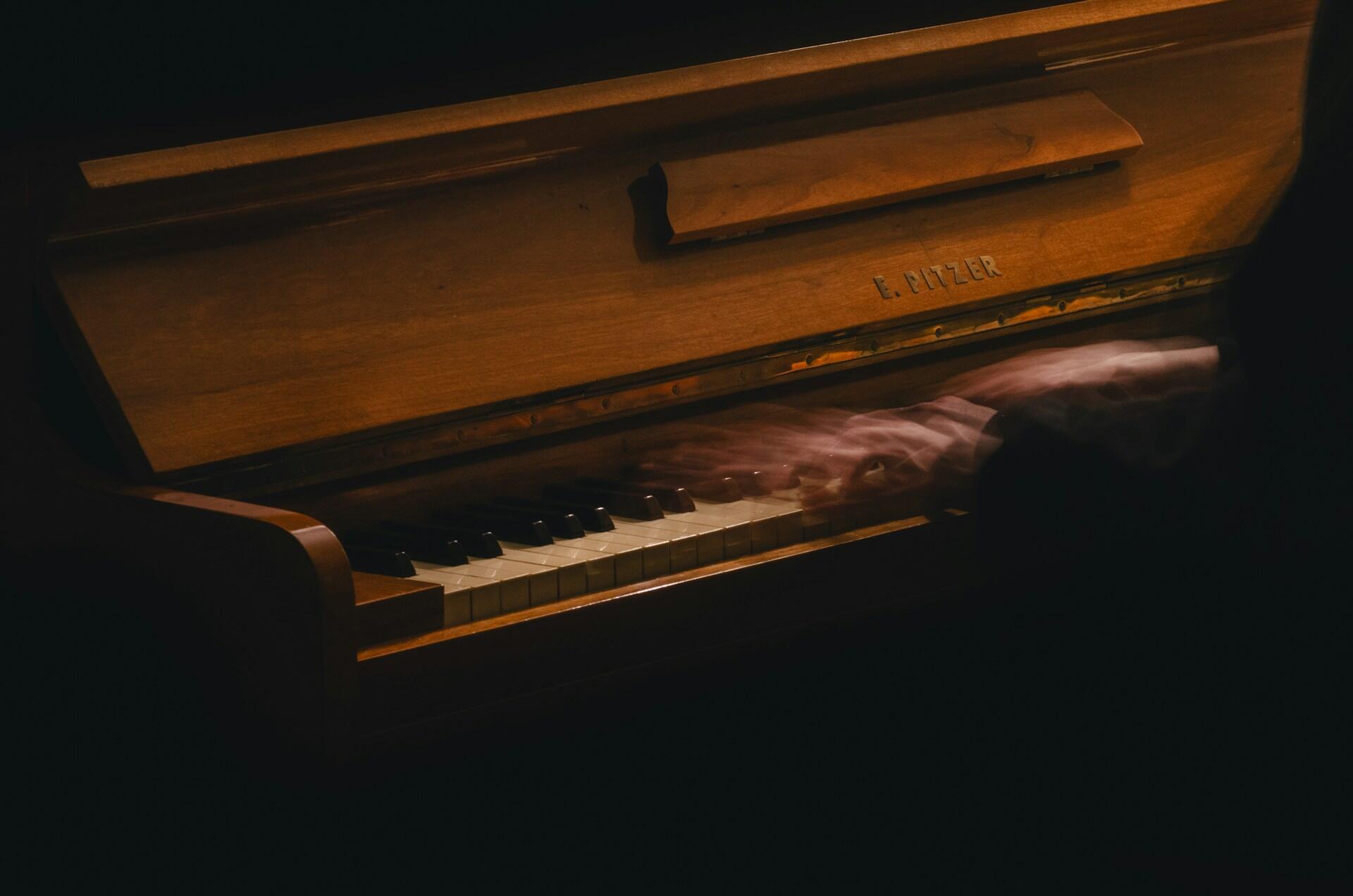Did you know that the piano's closest relatives didn't have legs or pedals and only had a third of its current strings? In this blog post, you'll not only discover the names behind the invention of the piano but also learn about its DNA, the general details about how it works, and how it evolved from one string to the more than 200 it has today.

From Pythagoras To Cristofori's Revolution: The Invention Of The Piano
Today, we know the piano as a manipulable instrument, controllable, producing specific sounds, but it wasn't always this way. Where does the piano's magic come from, with its soft and loud sounds resonating simultaneously?
The piano is a clear example of the evolution of tonality in music because its keyboard is built for it. Its earliest relative is the monochord, presumably created by the Greek Pythagoras.
This single-stringed instrument emerged after hearing how hammers sounded, generating a timbre when struck. Pythagoras measured the frequency of sounds and experimented with this sound box, verifying how the vibrations of its single string, when divided into precise parts, produce different notes, defining what we know today as musical intervals.
From the monochord, the first stringed instrument, emerged:
It was at this moment in the 17th century that Bartolomeo Cristofori's revolution came. The clavichord, or its derivative, the harpsichord, had no dynamics; they always sounded at the same volume. Cristofori, who had specialised for years on the craftsmanship of harpsichords, managed to make it sound loud and soft, "forte" (loud), "piano" (quiet/soft), precisely calling it "gravicembalo col piano e forte." How did the pianoforte differ from its predecessors?
🎵 The pianoforte works with hammers that strike these strings at different intensities; the harder a key is hit, the higher the pitch of the note.
🎼 Pianoforte instruments used leather-covered hammers, so unlike harpsichords, their strings were thinner and their soundboard less robust.
🎶 It had a range, it was already around five octaves (a modern piano has 7 and 1/3). To modify its resonance, and since pedals did not yet exist, knee levers were used, this touched the strings less, producing the softer tone.
After the gravicembalo col piano e forte, Cristofori's invention was called pianoforte, and today, we drop the word "forte" to simply refer to it as "piano." Bartolomeo Cristofori made around 20 of these instruments, which passed into the hands of his patron, the Duke of Tuscany Ferdinand II. This connection with royalty boosted the instrument's popularity and development in Europe.
Timeline of the Evolution of the Piano
500 B.C.
Monochord
900 A.D.
Dulcimer
14th century
Clavichord
15th century
Spinet
15th century
Virginal
15th century
Harpsichord
18th century
Gravicembalo col piano e forte (or commonly: early pianoforte)
Pianoforte
Grand piano
19th century
Upright piano
20th Century
Electric piano

The Piano Mechanics: The History Of The Pedals
This instrument's origins are European, of Italian creation, but with German, Scottish, Viennese, and even French refinements. The first piano prototypes had no legs or pedals, were fixed to a wall, and typically had around 60 strings (224 today). They were built in the early 1800s in Germany, where Bach was one of the first musicians to compose for these prototypes; the country was the only place where the piano was made for a long time.
The next significant evolution in the piano's history came with the pedals, essential for expanding sound possibilities and unleashing creativity. These mechanisms evolved from manual to knee pedals and, subsequently, arrived at the feet. One of the emblematic figures in the piano's evolution, specifically for pedals, was the instrument maker Gottfried Silbermann.
Based entirely on Cristofori's invention, Silbermann continued it with the invention of the first prototype of what is now known as the sustain pedal (the modern damper pedal), the most widely used and appreciated type of piano pedal today.
Silbermann's mechanism raised the dampers (the pieces of felt that rest on the piano strings) on the strings simultaneously, generating a reverberation effect.
Thanks to Silbermann and his piano innovations, Bach became familiar with the instrument—although he initially found the harpsichord more suitable—and later, Mozart, Haydn, and Beethoven boosted its popularity.
On the other hand, one of the first recognized patents for the pedal, as we know it today, is that of the Scottish composer John Broadwood, who was also a key figure in the history of one of the most famous composers in the world: Beethoven. Frustrated as he lost his hearing and nearly destroyed his Viennese piano, the musician received one with a powerful sound sent by Broadwood from London to Vienna in 1817.
Johann Andreas Stein, a former student of Silbermann from the Vienna School, was already working with knee levers—preceding the pedal—and improved them, making it possible to attenuate sounds and allow the player to play loudly or softly (piano or forte); Cristofori's instrument evolved in name and structure. Stein was also responsible for lightening the piano by creating a lighter keyboard and refining the touch.
The piano underwent many improvements to allow musicians of the time to enjoy a sound much more powerful than at the origin and greater expressive capacities. For those interested in exploring the piano today, you can find out about piano lessons Sydney through local music tutors.
The Piano Innovations During The Industrial Revolution
Thanks to the Industrial Revolution, piano production became easier; we passed from using wood to iron and from leather to felt.
It was key to the expansion of piano manufacturing and to improve the soft yet loud sound we enjoy today, with Johann Andreas Stein spearheading creations used by legends like Mozart.
From the late 1790s, the piano underwent numerous changes as a product of the Industrial Revolution, it allowed the virtuosos of the time a unique progress where they were able to:
Towards the 19th century, the French school, led by Sébastien Érard, joined the evolution of the piano. Érard introduced the double escapement action, which is fundamental for faster repetitions and essential in romantic virtuosity, and the Boisselot brothers consolidated the use of the sustain pedal, a mechanism that sustains only the active notes when pressed.
The second half of the 19th century and the industrial boom made it possible for new companies, new brands, new factories to emerge and contribute to the improvement of the piano, which was still known as the piano forte. Germany was the leading and innovative country at this time, with the Blüthner brand ahead of the movement:

The piano virtuosos as brand images
As in any sector, and as in any period, a brand must be accompanied by a muse. A muse who sells the product as unique among all. For the piano, the companies did not deviate from the rule. They went to seek the image of the best piano players to persuade the masses that their stage piano products were better than those of the competition. If you're into the main piano muses and developing your ear on this instrument, check our tutors for piano lessons Perth here.
Thus Beethoven, Bach, Chopin, Schubert, to name but a few (among the best pianists) lent their name to the great European piano manufacturers.
Piano firms
It was at this time that the modern piano was actually born, and we can't leave out the famous Steinway among the most significant changes and expansions of the piano's use.
The German Heinrich Engelhard Steinweg (his original surname), started his career as a passionate carpenter who wanted to "build the best piano possible"; he was the one who perfected the instrument, giving it the shape we know today. In 1836, at just 20 years old, he created the first grand piano in his kitchen.
Steinway's move to New York and the founding of his company, Steinway and Sons, took the piano to the next level, letting him experiment, perfect the pedals, and create various patents in his workshops, where, at the time, only Germans worked. Today, their craftsmanship remains highly distinctive and an excellent long-term investment for a musician, as Steinway pianos are handcrafted, hence their high market value.
The US: the piano factory giant of the 19th century
The piano arrived in the United States in the second half of the nineteenth century, with the creation of the two firms, the already mentioned, Steinway and Grodrian. These two early music companies lead the country. The practice of the piano was at its beginnings and was reserved for English emigrants, who had a culture of piano more developed than the premises of the new world.
Nevertheless, the United States quickly became the leader it still is today, with more than 200 manufacturers and more than 870 patents filed a hundred years ago. The main piano-making firms at the end of the 19th century were:
- Blüthner
- Broadwood
- Pleyel
- Erard
- Steinway&sons
Pianos of all shapes, sound and technical characteristics could be found among middle-class people of the time (especially those enriched by the Industrial Revolution, who wanted to learn the piano) and the bourgeoisie used pianos as well, for the sound only, for the beauty of the "furniture" that the instrument represents. As it is more accessible nowadays, we encourage you to learn to play the piano with one of our superprofs!
The Piano in the 20th and 21st Centuries: Piano Manufacturing From the Neo-Bechstein to Yamaha

With the progress in science, the advancement of industry, and manufacturing techniques, pianos changed and evolved into what we know today.
The piano succeeded in combining power, beauty, and perfect sound at the beginning of the 20th century, and piano performance practice became more popular
Just before the early 1900s, Henri Pape gave the sound of the piano a new dimension. He replaced the leather covers of the hammers. These blows which make sound with sheep's wool felt. This enhancement allows for a finer harmonization of the instrument's timbre with the strike when playing piano.
In Germany, the use of steel spun with diamond from 1902 renders a mineral side to the sound. Even today, firms such as Röslau, Bechstein, Vogel or Rose are constantly improving their use. If you're more curious about the most important names in this story, visit our article about the best pianists in the world.
Once its use and production became popular in the United States and Germany in the late 19th century, the piano industry underwent a meteoric rise. Due to the fine production lines used to craft them, it became one of the most powerful industries and employed thousands of people. The mass production of the piano also corresponded to the expansion of the enjoyment of music.

Thanks to the arrival of the radio, the phonograph, and the barrel and player piano, there was a cultural shift in how people approached music.
Many genres could be played with these two types of pianos (barrel and player); they weren't complicated to play since you didn't have to know the music sheet.
Enjoying music was easier than ever as all these elements played simultaneously.
Advances in pneumatic technology and automation through levers—originating with the invention of the locomotive—also impacted the evolution of the piano, which moved on to try to automate it as much as possible, thus giving rise to the barrel piano, the player piano, and the pianola.
The barrel piano was manipulated with a handle. The rotating cylinder contained one or more musical pieces, and inside, the pins activated the sounds by hitting the hammers.
The player piano was even better because to play it, you only had to place a perforated paper roll (which already had several pre-loaded pieces) in the reading mechanism and pump the pedals to activate the motor. The piano would then play the music encoded on the perforated paper roll, utilizing a pneumatic or electric mechanism that told it when and what notes to play.
These instruments also made it much easier for composers to record and preserve their works and experiments. In this context, when pianos, player pianos, and barrel pianos were enjoying success, the Great Depression hit. With the pressure to save the industry, the first electric pianos emerged.
Electric pianos date back to the late 1920s, and they replaced soundboards with other mechanical systems that allowed the reproduction of much more complex pieces.
Bechstein was the brand that invested millions in this innovation with the Neo-Bechstein model, considered the first electric piano.
It added numerous effects that even simulated other instruments, such as the organ, saxophone, or spinet, playing with the tones through an electrical amplification system connected to a large speaker placed next to the person playing it.
It was an instrument with a highly sophisticated and modern mechanism for its time, allowing the player to control the force that struck the strings when playing. We invite you to test your own piano abilities with the ten most difficult pieces written for the piano.
Although its size and the tones it reproduced—unfamiliar to what people were used to then—did not allow it to be commercially successful, the Neo-Bechstein was the basis for other companies to continue developing the instrument.
Asia and Japan make their way with Yamaha
Japan made its way relatively late. The national leader of the musical instrument, Yamaha, was only created in 1887 and began making pianos in 1900. It is the Meiji family that installs the Yamaha brand at the top of the piano technicians, with the very famous Disklavier.
Their research of excellence in acoustics makes the Yamaha instruments the crème de la crème at the musical level, even today. Although the Young Chang pianos have been starting to make their place in the piano market.
A know-how that has been exported to neighbouring countries like South Korea and China, that stay in the background.
Key Names on the History of the Piano, a timeline
Bartolome Cristofori
The father of the Piano
Around 1700 he built the gravicembalo col piano e forte
Gottfried Silbermann
Inventor of the damper pedal
J.S. Bach initially criticized his pianofortes, but later endorsed them
John Broadwood
Strengthened the piano’s frame
Expanded its range to 6 octaves and increased volume
Johann Andreas Stein
Escapement action and lighter keyboard
Sebastian Érard
Double escapement action
Still used in modern grand pianos, allows rapid repetition of notes without fully releasing the key
The Boisselot Brothers
The sostenuto pedal
Joseph Pleyel
Pianos with a clearer and lighter sound
Robert Wornum
Development of the upright piano
Enabled pianos for domestic use
Steinway
Perfectioned piano building
Revolutionized the instrument with the cast iron frame, overstrung scale, and important acoustic innovations
The Electric and Digital Piano: How Its Versatility Changed Music Forever
After the 1929 crisis, the wars, and the broader development of the music industry, the piano innovations continued to be a palpable influence, evident in the rise of jazz, rock, and funk; a compact and portable alternative was needed to keep up with the pace of musicians and the evolution of live music. Discover even more about the piano legacy in our articles!
The electric piano arrived in an ideal context with the appearance of electric systems, which gave it a unique versatility and brought the instrument closer to all audiences.
By creating sounds with electrical impulses and signals instead of strings, the possibilities of creation became infinite.
Thanks to the work of Fender, Wurlitzer, and Yamaha, new sounds and textures arose. This marked the golden age of the electric piano, giving it the lightness and timbre that the piano industry needed in the 1960s and 1970s.
These models were the predecessors of digital pianos in the 1980s and, of course, helped push the creation of new sounds with keyboard instruments through the synthesiser, a pinnacle of all this evolution.
The synthesiser combines an infinite number of textures and sounds, making it seem as if several instruments are being played simultaneously. Today, thanks to mechanical evolution, we can even talk about hybrid pianos that combine the traditional acoustics of the piano with technology.
In the 21st century, the digital age has allowed us to integrate effects, connectivity via Bluetooth, a metronome, and other sensors into the most modern pianos, enhancing the art of composing and performing.
The piano is a key piece in the history of music, and without it, music would not be the same. Not only is it a traditional instrument, but thanks to its versatility, it is the basis of many musical genres and an inspiration to millions of musicians and music lovers.
The piano industry is continuously flourishing. As in its beginnings, it went through the twentieth century by adapting to new technologies. Would you be up now to start online piano lessons?

















